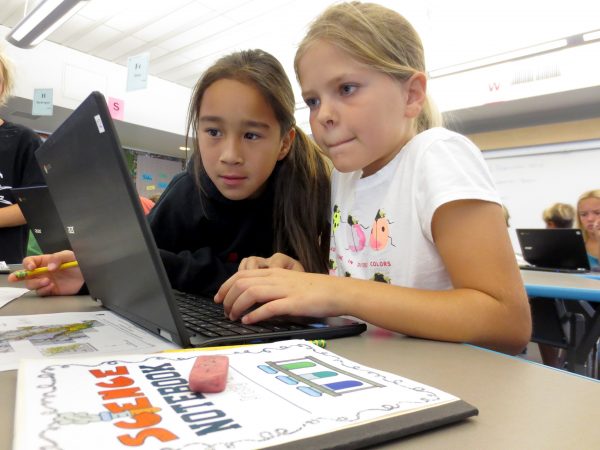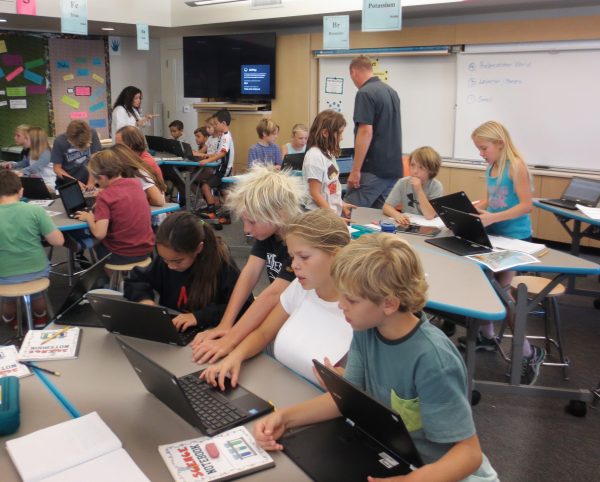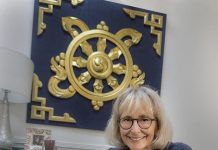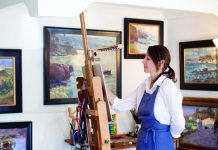
In devising a bid to design an imaginary amusement park with a roller coaster, 9-year-old students Carly Anderson and Presley Jones diligently research potential sites by analyzing topography and earthquake history while huddled around laptop computers.
Their assignment in Jacqui Cohn’s Top of the World fourth grade class combines science, technology, engineering and math, better known as STEM curriculum.
Carly and Presley decided on San Raphael as their city of choice. “It says on the website that it has been 30-years since an earthquake is going to strike,” they explain during their classroom research.
Gavin Simon, 10, searches for images of a San Jose earthquake on his laptop, but only finds the soccer team San Jose Quakes. His partner, Katie Baker, 9, finds property for sale and starts checking to see if the land is protected or if zoning would permit development with a roller coaster.
The students must soon make a choice between three cities, including San Jose and Palo Alto. They will create a presentation using Google slides and share their information in Google documents for a class presentation on a wall monitor.
The project takes place in a regular classroom designated a STEM lab, where many of the 615 students enrolled in kindergarten through fifth grade at the 50-year-old school research and collaborate while absorbing an inquiry-based science curriculum.
Working in a team is an important part of the program, stresses TOW’s Cohn. “It’s like an engineering team. They have to deal with constraints of materials and budgets. When they are part of a team they really have to find ways to contribute based on their skills.
“They didn’t choose to be together. They were brought together so every role they have is important. Collaboration is huge,” Cohn said.
Within the district, students in kindergarten and first grade work in the classroom on school-owned computer tablets, while second through fourth grade students work on laptops. Fifth graders are allowed to check-out chromebooks, computers designed to be used while connected to the internet, and are not allowed to bring their own device. In sixth through 12th grade, students are allowed to checkout chromebooks or bring their own device, according to Mike Morrison, the chief technology officer.
While school administrators have integrated STEM curriculum into the classroom, they hope to soon add an art component and elevate the program from STEM to STEAM.
Principal Michael Conlon said he hopes to incorporate art into the STEM classroom early in 2017. The district’s effort to give new emphasis to art follows the adoption of revised visual and performing arts standards by the California Department of Education and in August, says the CDE website.
Alycia Odipo, the district’s assistant superintendent of education, expects to soon start planning visual and performing arts curriculum with newly hired Bridget Beaudry-Porter, she said in a statement. But she says it is too early to say when it will be integrated into the school curriculum. “We’re building a timeline now,” Odipo said after the Nov. 15 school board meeting where consultant Jennifer McCluan was hired to advise and support so-called Next Generation Science Standards in the high school and middle school. The agreement will pay McCluan $1,500 per day up to $10,5000 for services through June 30.
California becomes the first state in the nation to adopt a science framework based on Next Generation Science Standards, the education department website says. The science framework expands and refines discussion of climate change and for the first time includes engineering, environmental literacy, and strategies to support girls and young women in science.
For example, under the framework future curriculum for high school chemistry students would explore the increasing acidification of the world’s oceans, the causes, and potential remedies, education department site says.

Principal Michael Conlon checks on student work at TOW in a fourth grade STEM lab on Nov. 9, 2016
Photoby Marilynn Young




